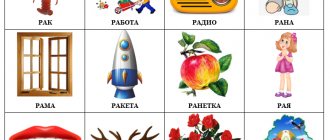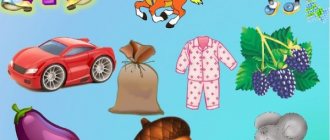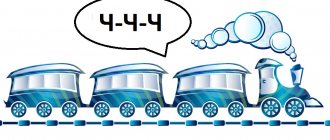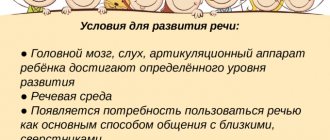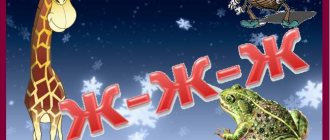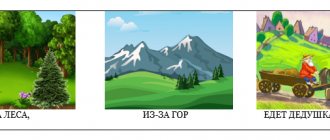Disturbances in the reproduction of C and C
Speech therapists here
Defects are divided into 2 groups:
- Sigmatism (distorted reproduction). This includes types of violations:
-
labiodental
. The sounds “S” and “S” are replaced with the phoneme “F” (Son - Background, Owl - Fova); - interdental.
When playing, the tip of the tongue is between the teeth.
The child has a lisp when pronouncing words
; - side.
The tongue falls to one side when pronouncing a sound; - nasal.
It is observed in children with anatomical and physiological defects (rhinolalia, rhinophonia).
2. Parasigmatism (the sound “S” is replaced by other letters). Kinds:
- dental
Replacing “S” with “T” and “S” with “Th” (Son - Tone, Blue - Tiny); - hissing.
“S” and “S” to “Sh” to “Shch” (Light - Shvet - Shvet); - mitigation errors. The hard
“S” is replaced by “S” (Dog - Syabaka); - defects of deafness and voicedness.
“S” and “S” to “Z” and “Z” (Snow - Zneg).
Violations lead to defects in sound pronunciation (dyslalia)
. The child may also develop problems with reading (dyslexia) and have difficulties in writing speech (dysgraphia here).
LiveInternetLiveInternet
Quote from Olenka_Kovalenko's message
Read in full In your quotation book or community!
Automation of whistling sounds С, Сь
With normal speech development, by the age of five, the child correctly pronounces all the sounds of his native speech. If the baby has shortcomings in sound pronunciation, then work to correct them takes place in three stages: Articulatory preparatory exercises for a specific group of sounds (in this case, these are the whistling sounds S, S', Z, Z', Ts) Calling out this sound by imitation (its production ), Consolidating the correct pronunciation of this sound in syllables, words, and phrases. Training in the correct pronunciation of whistling sounds is carried out in a certain sequence: First, work is done on the sound C and its soft version S, and games and exercises are conducted to automate the correct pronunciation of these sounds. Then the child learns to pronounce the sounds З and Зь. And exercises and games are conducted to automate these sounds. And then the child practices the correct pronunciation of the sound T. Automation of whistling sounds S, Sb: games, poems, tongue twisters, tongue twisters. Today in this article you will learn how to help your child learn to correctly pronounce the sounds S and S (whistle sounds). We will talk about the third stage - automating the correct pronunciation of these whistling sounds. For this purpose, games, play exercises, sayings, jokes, riddles, sayings, tongue twisters, songs, and stories are used in which the sounds C and Сь are often found. For games and exercises to automate the sounds C and Сь in a child’s speech, you will need a list of words with the sounds C and Сь, which is given below. This is important to know and take into account: When choosing words to automate the sounds S and S, you need to take into account that in Russian, before the soft consonants t, l, ny, the sound S is pronounced softly. And therefore, in the words lingonberry, donkey, plum, suit, thermometer, the soft sound is S, and not the hard S. Words with the sound S: The sound S at the beginning of the word - sled, dog, cheese, boots, candle, pig, table, owl, bench , scoop, sandals, fireworks, satellite, jump rope, pine, magpie, scooter, plane, glass, catfish, saber, whistle, juice, chair, kindergarten, cod, lard, bag, ship, construction site, builder, rolling pin, puff pastry, tablecloth , glory, sweetness, sugar, slush, frying pan, nightingale, snow, snowflake, snowman, snowfall, Snow Maiden, soldier, icicle, elephant, laughter, knitting needles. The sound C in the middle of a word – wheel, mask, scales, cabbage, fox, paint, sock, dishes, oil, oil can, beads, radish, wheel, pump, sausage, flippers, sand, meat, vacuum cleaner, pan, tie, bushes, spring, rhinoceros, herd, shepherd, snowdrop, baseball cap, boletus, badger, astronaut, spaceport, dump truck, bowl. The sound C at the end of a word – nose, globe, ear, coconut, canopy, pineapple, bus, apricot, tennis, compass, gladiolus, tray, kvass, hour, forest, rice, box, pump, cactus, oats, cupcake, sail, dog, fruit drink, belt, frost (we write the letter z, but the sound c is heard) Words with the sound Сь: The sound Сь at the beginning of the word - herring (herring), hay, salmon, surprise, sideboard, earrings, heart, saddle, sister, middle , lilac, plum,. The sound S in the middle of a word - geese, orange, taxi, autumn, donkey, pig, letter, sausages, donkey, bicycle, gazebo, cornflowers, leaves, lingonberries, suit, thermometer. The sound S at the end of a word - goose, elk, crucian carp, lynx. Games for the development of phonemic awareness. Sound S, S. Game "Clapping". Game option 1. Ask the child to clap if he hears the sound S in a word. Mix up words with the sound S in different positions (at the beginning, in the middle or at the end of words). For example: telephone, boots, dad, fruit drink, book, rain, nightingale. The child claps when he hears a word with the sound C (do not confuse the sounds C and Сь themselves - these are different sounds, although the letter is the same!) If it is difficult for a child to identify the sounds in a word by ear, then say the words in a drawn-out manner, for example mmmoooooorrrsss. This game teaches the child to distinguish different sounds in speech and develops phonemic hearing. Option to complicate the game: You can give the task to clap if you hear the sound C and stomp if you hear the sound Cb. Game "Clapping". Game option 2. Tell your child: “Clap if you hear the syllable Sa.” Next we say a sequence of syllables, for example: sa, na, sha, sa, for, ra, yes, sa, tsa, sa, la, cha. Does the child distinguish between the sound C and the syllable SA in the speech stream? Is it confused with other similar sounds? Children very often confuse the syllable sa with the syllables za or tsa, as well as with hissing syllables with the syllable sha. And it is very important for us to teach children to distinguish between these sounds and syllables. This is also important for teaching writing at school, so that the child does not confuse these sounds and the letters that represent them in written speech when he begins to write. Game "Echo". Repeat three syllables in a row, and the child should repeat them as an echo, that is, a little quieter than you say. If your child repeats three syllables easily, increase the number of syllables in the repetition chain. Be sure to praise and encourage the little “echo.” If the “echo” makes a mistake, repeat the chain of syllables again. Examples of tasks: sa-so-sy as-us-is-as sam-sad-sav, so-su-si-su asa-aso-asu-asy, etc. Game "Guess what whistles?" You will need two pictures - “pump” and “water flowing from the tap”. You can draw them yourself (schematically depicting the pump and tap). The main thing is that they are recognizable to the child. Show your child a picture of a pump. Say: “The air coming out of the pump whistles like this: ssssssssssss. He whistles angrily sss!” Show the second picture and say: “Water is pouring from the tap. The water whistles softly, sit like this.” Ask the child to say how the water whistles (ss-s-s-s) and show the corresponding picture. Then ask him to imagine how the air whistles from the pump - sssss - and show the desired picture. Next, say: “Now we are going to play an attentiveness game. If you hear the pump song - a solid sss sound - then pick up the picture of the pump. And if you hear the song of water - a soft sound - then pick up a picture of water.” You say these sounds separately (s-s-s-s-s-s-s-s), and the child picks up the desired picture. First the game is played with sounds, then with words. You say a list of different words in random order: door, nightingale, herring, frost, banana, hat, water, and so on. If the word contains “pump song - hard sound C,” then the child raises up the picture with the pump. And if the word contains the sound s - a soft sound, “song of water”, then you need to raise the picture with water. If there is neither one nor the second sound, then there is no need to raise the pictures. Joke game with sound C "Confusion". Children are asked to guess which words are mixed up and put them in their places. Examples of confusion-jokes with the sound C (Author L. M. Kozyreva, from the book “Speech Development. Children 5-7 years old”): A carp lives in the forest. A pheasant swims in the river. (Correct - “A pheasant lives in the forest. A carp swims in the river”). They gave us a delicious robe for lunch. Alyonushka has a new salad. A polar cod was flying in the clouds. There was a seagull on the table. The pike perch has two eccentrics (correctly – “the eccentric has two pike perches”) A few more confusions of the famous author of poems for children A. Shibaev: In front of the children, painters are painting a rat. (Not a rat, but a roof. Instead of the sound S, you need to put the sound Ш). They say that a fisherman caught a shoe in the river. But then he got hooked on the house. (Not a house, but a catfish) The lazy guy is lying on a cot, gnawing, crunching, on guns. (Not guns, but dryers) The lion drops its leaves onto the yellowed grass. (Not a lion, but a forest) A few of my own jokes - confusions for activities with children: That's it, daughter! Beauty! My daughter has a long goat! (not a goat, but a scythe). At Anya’s house, the bowl lives, dances, plays and sings songs! (Not a bowl, but a bear. Another correct option for replacement is a pussy). Katya ate a tasty tooth. Katya's soup is sick. (On the contrary, I ate soup and got a toothache). There is an owl in the room. And there is a sofa sitting in the forest. (No. There is a sofa in the room, and an owl in the forest). Children usually laugh when they hear a joke - confusion. But not every child can correct a mistake and unravel the confusion. If a child has speech impairments, then you often have to give a hint - “Which word is lost? Which word fits the meaning? The answer also begins with the sound m. This is a toy. Guess what it is?”) Games for automating the sound S and S in words: Game “Tails” (author of the idea - S.A. Maksakov) Show the child a strip of paper and tell him that different words are hidden in it - encrypted. The words are all different, but they have the same beginning. We need to figure out what words these are. An example of a task: hidden in a strip are words that begin with “ska.” What words are these? Tell your baby: “I’ll start, and you continue: ska-... (make-up), ska... (rolling), Ska... (zka), ska... (rub).” If it is difficult for your child to guess, draw a small picture in which you depict part of an object and ask him to guess what kind of object it is and what kind of word it is that starts with “ska”. Another example for this game is words starting with “sa”: sa... (fly), sama, sleigh, scooter, Saratov, Sasha, Sanya, independent, Samarkand, lard, bag, samovar, boot, Savka, garden, garden , gardener, soot, carp, fireworks, net, saber, sausage, sardines. If you find it difficult to find words for a certain syllable, then there is a good helper - a dictionary. Introduce your child to a Russian dictionary, show him how to find words in it, read to him about several new words starting with the desired syllable. Game “Assemble a basket”. I usually play Tails and other game variations a little differently. It is very important for preschool children to see clearly the results of their actions. But in speech there is usually no such visual result that can be seen or touched. This is why children love to draw, sculpt, and do various crafts, but do not really like speech exercises. Let's take this feature of young children into account. I came up with a special game technique for teaching speech and called it in my research “visual result of children’s speech.” Despite the complex name of the technique, it is very simple and interesting, and all children like it, getting them interested in completing the speech task. The essence of this technique is for the baby to see that his speech action leads to a visual, tangible and vital result. Tell the children that the Old Man-Speech lost all the words from his basket and was very upset. How can I help him? The words are lost - scattered all over the world (or throughout the album) and need to be collected again into one basket. The basket contained words with the sound S. We need to find them among other words. This is a game situation in which we will use visual speech assessment. Let's see how in a situation with a basket we can organize a visual assessment of children's speech actions. We draw a silhouette of a basket on a board or easel, which we will “fill” with words. The task is to fill the basket completely. This is how you fill the basket: As soon as you and your child come up with a word, draw this word in the silhouette of a basket (for example, it will be an oval) and paint it over (color the oval). It's as if we "put" the word in a "basket". Next, each word with the sound C adds another oval to the basket. The game ends when we have completely “filled the basket with words.” You can take a real basket and fill it with “words” - cubes from a building set. In this game you can give any tasks - put words with the sound S in one basket, and words with the sound S in the other. Or collect in a basket only words in which the sound C is in the middle of the word. Or only words starting with the syllable Sa. Children usually remember well where the word each child came up with is in the basket, what color it is, and point with their finger: “I put this in.” And this is Svetino’s word.” If you play in pairs with a child, then he remembers well where your word is, and where his words are and “who put in more words.” Game "Bag and Net". This game was born to me unexpectedly during speech classes with preschoolers. I know that not all children are interested in matching words with sounds, but I wanted to make this activity fun for kids. But I really didn’t want to use competition for motivation (who can come up with the most words?) Why? Firstly, because some children in this competition are obviously at a disadvantage. Secondly, because there is too much competition in our lives, and too little cooperation. So we started playing the “bag and net” game - a game that teaches everyone to do tasks together and enjoy the overall results together. And all the children began to like the exercise of matching words with sounds; moreover, the children continued playing with the bag and the net even after class. How to play? We draw a rectangle with handles - this is our bag in which we will put groceries. Next we draw an oval with handles. This is our grid. Together with the children, we determine what sound the word “bag” begins with. Yes, from the sound S. This is a hard sound. Therefore, we will put products in the bag that have a hard consonant S in their names. And what sound does the word “grid” begin with? Yes, from the sound S. This sound is soft. Therefore, we will only put words in the grid that have the soft sound S’ in their names. We begin to get ready for the trip and put the necessary things in a bag and net. The task is not to confuse what goes where. And have time to get ready for the trip and put items in a bag and net in 5 minutes. Let's set a timer. Game options: You can give children a set of pictures that need to be placed in a bag, in a grid, while there are extra pictures that need to be put aside and do not need to be used in the game (since these words do not have given sounds). You can set the task differently, without pictures - come up with as many names as possible with the sounds C and Сь. We draw each word invented by a child or a group of children as a rectangle inside the outline of a bag or grid. And we complete the task - fill the bag and the net in a given time. The children and I came up with more than 50 words in this game! I am always amazed at the activity of children in this exercise, I am surprised at how they want to “put” their word into a common grid or bag. At the end of the game we are happy that we were able to come up with so much together!!! By the way, another idea that is suitable for children aged 6 years and older. Before the game starts, ask the children how many words you can put in the bag and net together. Write down your expected outcome. Then compare. Show the children how many words they planned to find and how many they actually found. Usually children say that they can find 10, 15, 20 words. How surprised they are that they were able to select so many words as a whole group, two to three times as many! “We didn’t even expect it!” – that’s what they usually exclaim. And this is very important for building self-confidence in children, the idea that they can do a lot, even things they don’t know about themselves yet! Here are the words for bags and nets on the topic “Products. Food”, which we collected all together. I admit that I didn’t even expect that our bag and net would be so full, there wasn’t even enough space! And the children were satisfied and happy with their success! The bag will contain: salad, soup, sauce, sausages, dried fruit, butter, cheese, spaghetti, cabbage, pickle, salt, sugar, pineapple, apricot, soufflé, plum, rice, prunes, asparagus, coconut, radish, lingonberries, currants, russula, pie, juice, cheesecakes, sour cream, kvass, fruit drink, beef stroganoff. The net will contain sausages, syrup, seeds, salmon, crucian carp, orange, herring, boletus, chanterelles, peaches, jelly, oatmeal, salmon. Game "Guess what's in your hand." Place in the bag an object or toy whose name contains the sound S (or the sound S, depending on the task). Give the bag to the child. Invite them to guess by touch what is in the bag. The child needs not only to guess, but also to correctly pronounce the sound in the name of this object. Games for automating sound C in phrases. Game "Come here" This is a game for a group of children, but it can also be played in pairs. Then you need to show your child a re-enactment of how animals play such a game. Option 1. Playing in a group. The leader of the game stands away from the group of children. He calls one of the children to him, calling him by name. At the same time, he must come up with a word with the sound S. For example, the leader is Vasya. Vasya calls: “Lena, come here! I found the whistle! (that is, the child came up with what he found - an object whose name contains the sound C). Lena runs up to Vasya and figures out what she found and who she will call. Lena calls: “Katya! Come here! I found a pussy! Katya runs up and comes up with what she found. You cannot repeat words. Katya says: “Denis! Come here! I found a fairy tale! and so on. In the game you need to pay attention to the correct pronunciation of the sound. If the sound is pronounced incorrectly, then you still need to “find something,” that is, come up with another word with the sound C and pronounce it correctly. Option 2. Staging. If you conduct such a game with toys in an individual lesson, then tell your child how the toys once played the game “Come Here.” Offer to play the same way. Select toys with sound for the game: pussy, fox, dog, elk, sailor, Sasha doll and others. Next, pretend to play with toys. You speak for the first driver, and then the child plays, performing all the roles in turn. For example, the fox says: “Pussy! Come here! I found a sausage." The pussy runs up and calls the next toy: “Sailor! Come here. I found the wheel." Game “Shop” You will need toys or pictures depicting objects that have the sound C in their names (see the list of words with the sounds C and Сь at the beginning of the article). To “buy” a toy or picture in our store, you need to name it correctly, “pronounce” all the sounds and say where the sound C is located in a given word - at the beginning of the word, in the middle or at the end of the word. When pronouncing the name of an object, the sound C stands out a little, pronounced exaggeratedly, for example, “sssslon - the sound C is hard, stands at the beginning of the word”, “missssska - the sound C is hard, stands in the middle of the word”, “los'l - the sound C is soft, is located at the end of a word." An approximate dialogue in the game is given below (the dialogue, of course, can be changed, saturated in other words with sound C). Pay attention to the correct pronunciation of sound with children in all replicas of the seller and buyer dialogue. Note: This dialogue can be introduced when the child already pronounces the sound with. Otherwise, the triple task “pronounce it correctly sound + make a dialogue + determine where the sound in the word” will be too complicated for children. - Hello! - Hello! Please pass. What do you want to buy? - Give me, please, an elephant. How much does it cost? - We have a secret in the store. Guess the secret - you can get an elephant as a gift. Tell me, where is the sound C is hidden in the word Elephant? - In the word "sslon" the sound is solid, stands at the beginning of the word. - Right! Here is your elephant! Goodbye! We will be glad to see you again! - Goodbye! Purely spokes in the automation of sounds with and C: networks often do not seem funny and unnecessary or even useless to a specialist. And indeed, at first glance, why is a child at five to six years old to repeat such simple words and phrases that are clear even a two -year -old? In fact, pure twists are very necessary. The athlete before the jump makes a start to achieve a better result. So the pure -spoke is a kind of “run” for a child, which helps him move from the correct pronunciation of sound in the syllable to the proper pronunciation of sound in the phrase. This is a training of articulating organs in which it is easy for a child to follow his correct pronunciation. In addition, purely bindings can be quite composed with the child and compose your own options. Below you will find a video with clean -twisters - songs for automating the correct pronunciation of sounds with and s. Pure-spokes with solid sound with for automation of sound with: AS-SAS. The light in the window went out. AS-AS-AS. We bought pineapple. OS-OS. On the deck the sailor. OS-OS. A tray is on the table. Us-US. There are a lot of beads on the Christmas tree. Sys-ss. The cat catches rats. SY- Sy- Sy- Katya has two braids. Sy-Sy-Sy-Grandfather has a long mustache. Sa-s-s-here is the fox runs. Co-SO-SO-The fox rolls the wheel. Sa-s-s-this is the wasp. Su-Su-Su- drive off. Sa-s-s-fly away, wasp! Su-Su-Su-berries in the forest. Sy-ss-ss-ticks the clock. Pure-spokes with soft sound: Si-si-th- water into the house carry. Si-si-a taxi arrived. Ce-se-s. The ribbon in the spit. AS-AS. The crucian carp is floating. Uys-oos. Here is a beautiful goose. Os-ox. In the clearing moose. Pure-spies-songs (video) for the automation of a whistling sound S. OSA-Automation of a firm consonant with humorous clean-making “Correct the error”. There is a special type of pure-handed- purely- jokes with a deliberate mistake. Here are our author's pure -spokes with errors. Come up with such clean spokes yourself - it's simple and fun! Children can also participate in the inventing of purely speakers - jokes for their peers and babies. Be sure to write down the compositions of the children. By this, you not only preserve the unforgettable moments of childhood for the future of the child, but also show him how important and significant his speech creativity is. Sa-s-s-s, a fox flies over me. (Not a fox, but a wasp!) Sy-ss-ss, Sinichka has a mustache. (No, the blue has no mustache. And who has them? What word has lost? The kitten has a mustache, the little white has a mustache, the tigerk has a mustache-come up with different correct options for the pure-spoke) Su-Su-Su, I have a kitten pass . (No, the kitten is not grazed. I must say differently: I am a goat pass, or I am a lamb pass). Co-SSO-SO-SO, the wheel was sad (no, the wheel is not alive, I must say differently: “Co-sogo-sso, the wheel rolled, the wheel fell off, the wheel spun, the wheel grinded, the wheel creaked”-come up with different options). In addition to purely speakers, there are also very interesting speech exercises called “answers-repeaters” of the answers- the repeaters with the sound of S. will give an example of the answers invented by the famous speech therapist T. A. Tkachenko. You will find many different answers- the repeaters in her books from the series “Pronounces the Sounds correctly”. During the answers - the repeaters must be accustomed to the child to make sounds correctly. You can immediately give an answer to the question in the response - the repeat, and it is best to give the task to guess how to answer the question. Rule - in the word response there should be a sound C and this word should rhyme. To whom do I give two bowls? Pussy, pussy, pussy, pussy. Livery pours where from heaven? In the forest, in the forest, in the forest, in the forest. Who carried the slippers to the sofa? Dog, dog, dog, dog. What you yourself could not finish? Juice, juice, juice, juice. And these are our author’s answers - repeaters invented in the idea of T.A. Tkachenko: Did you look at the window? The sun, the sun, the sun, the sun. What are we going to drink now? Kvass, kvass, kvass, kvass. Who did we see in the forest? Fox, fox, fox, fox. What is a girlish beauty? Spit, braid, braid, braid. Where will I find apples? In the garden, in the garden, in the garden, in the garden. What is in the hands of Sanka in the hands? Sled, sled, sled, sled. What will we all pour us at lunch? Soup, soup, soup, soup. The tongue twisters and phrases with sound with: The wasp does not have a mustache, but the antennae. The little sleigh of sleds go themselves. Sanka has brand new sledges. Senya and Sanya have a catfish with a mustache in their nets. Kosi, braid, while dew, Downs Down - and we are home. Senka is carrying Sanka and Sonya on a sled. Sanki - bracket, senka from the feet, sled to the side, sleeping in the forehead. Everything is in a snowdrift! Everyone would have to sit down and eat. Sveta and Stas are always together. Son Seva himself eats soup. Dusi has blue beads. Bones have guests. The canopy has a sled. The cat Vaska has a mustache in sour cream. Ten bunnes are sitting on the pine tree. Semenit to the bench of the goslings of the family. Senya in a dream sits on a pine tree. Sits on Seva pine in a dream. A neighboring neighbor has a neposed neighbor. The neighbor has a fidget neighbor homebody. Seven of us sat in the sleigh ourselves. The bridge has two chanterelles behind the bush, two sisters. Senya's jerk of hay. Sleeps calmly well -fed catfish, sees a calm dream. Sonya with a canopy of hay is mowed, they wear hay themselves in the canopy. The light goes into the forest, in the forest. And Sveta has a tuesok, tuesok. Mom sat on the bench. On the right is Seva. Glory - on the left. Poems with sound with: In verses, you need to monitor the correct pronunciation of the child of the sound he has mastered with or s. If the baby is mistaken, then ask him to correct himself, to recall that his tongue has already learned to say the sound S. Also pay attention to the intonation expressiveness of the child’s speech. What intonation is it better to pronounce the phrase? Try repeating the same phrase in surprise, joyfully, sadly, delightedly, frightened. We will build the plane ourselves, rush over the forests, rush over the forests, and return to mom (A. Barto). Sitting a sparrow on the pine tree. He fell asleep - and fell in a dream. If he had not fallen in a dream, he would still sit on the pine tree. It smells like a smack of turpentine and paint. The glass is smells of with a window putty. You smell a fresh board and a fresh board past the carpentry. (J. Rodari) Soroka once sat on a pear, one forty was sitting on a pear, forty once on a pear sat on a pear, solved forty things. And she jumped once - and flew back, and jumped two - and flew up, and jumped three - and flew up, but still could not decide forty forty things. (E. Berger) Kuskin Gore. The pussy cries in the corridor. She has a great grief. Evil people of a poor pussy do not allow to steal sausages. (B. Zakhoder). Two tits flew to the pine tree, two tits whistled about spring. - How much light! How much light! It has become blue! Summer is coming soon! Summer is coming soon! Beauty! Beauty! (V. Suslov) looks the sun in the window, shines into our room. We will slam in your hands, very happy to the sun! (A. Barto) Snow melted! The snow melted! This news is not easy! This means - a real spring comes! Grass is green, the sun shines. A swallow with spring in the canopy flies to us. With it, the sun is more beautiful and spring is a mile. Hello, we’ll get high from the road soon. I'll give you grains, and you sing a song. What of the distant countries brought with me. The icicle was frightened of the height. The icicle from fright began to cry. And therefore, the slush came again. Sleepy day, sleepy day. Laziness to blow with sleepy winds. Sleepy chickens peck laziness. Sleepy day, sleepy day ... Pussy, pussy, pussy, scumbag! Do not sit on the path! Our Simochka goes - it will fall through the pussy! My elephant is sleeping in the corner, two small slingshots to sleep long - they want to. Owls. Take a look at the little louds, the babies are sitting side by side. When they do not sleep, they eat when they eat, they do not sleep. Lullaby. Meadows are sleeping, forests are sleeping, fresh dew decay. In the sky, the stars are burning, in the river the trickles speak. The moon looks at our window, he tells small children to sleep. It is dark in the forest. Everyone has been sleeping for a long time. One owl does not sleep. He sits on a bitch. Elephants are smart, elephants are humble, elephants are calm and strong. Hello, winter guest! We ask for mercy to us - the songs of the North to sing through the forests and steppes. Such a frost! Such a frost! He takes by the nose, ducks to tears. Such frost is crackling! Stuck, stuck, got bored. Such a frost, such a frost! Skory your nose, you have grown to the eyebrows. So healthy frost! It goes, crunches the road. Pines. Pines to the sky want to grow, they want the sky with branches so that the weather was stood clear during the year. (I. Tokmakova) Somehow four guys rolled down from the hill. Two in the sledges are sitting. How much did it fall into the snow? (N. Konchalovskaya). Proverbs and sayings with the sound S. Why do they say that? Don't sit in your own sleigh. No matter how much the wolf is feeding, he looks into the forest. Take care of your nose in severe frost. Video for speech classes with children on automation of whistling sounds with and s. Songs. The samovar himself cooks. Sonya loves to sleep very much. They began to call Sonya Sonya. Sonya - Sonyushka Pig. Poem-dialogues with S. sound Read the poem by roles. Are the wolves sleeping? Sleep. Sleep. Are the bees sleeping? Sleep. Sleep. Are birds sleeping? Sleep. Sleep. And the foxes? Sleep. Sleep. Everyone is sleeping in the world. Sleep. Only I am a steam locomotive - we do not sleep, we do not sleep, and flies to the very stars to the sky, smoke to heaven. A dialolog game for automating sound with and C in phrases according to the poem “Is all well-fed” at the heart of this game I invented for speech classes with children-the poem I.G. Sukhina. We play like that. We lay out in front of the child pictures with the image of girls (you can find many pictures on the Internet and print them for this game). Under each picture there should be an inscription (the name of the girl is printed). How to play? We get acquainted with the cards. The child is asked to read or guess the names of the girls. In each name there is a sound S. We check if the child remembered all the names (3-5 cards participate in one game). Next, make one of the girls. To do this, under one of the pictures, we put the pictogram - a schematic image of a displeased face. This girl in the game will be hungry, "not full." It will need to be guessed in the game. Put an icon under the image of a girl so that the child does not see your actions. We ask the baby to guess who they forgot to feed, who is not full? We say the text. For example, the child asks: "Is the light well?" You answer the “Sveta fed” if this picture is not made up. Or answer "Sveta is not full! She is hungry! " Then the child guessed, congratulate him, and in the next game you will change roles - the child makes you a girl, and you ask him and must guess the name of the mystery girl. The game is very interesting! Children love to guess! Sometimes they need to tell the names if they still do not know how to read. Useful tips on holding the speech game "Are all full?" You can also play with the names of boys. You will find a list of names for the game below. In the game, you need to pay attention not only to the correct pronunciation of sounds with and C, but also to the correct intonation - interrogative and narrative in the question and in the answer. You can, as an option for the game, give a child to choose a treat and “feed” the girl by finding a picture with a image of food, in the name of which there is a sound C. For one game, take 4-5 pictures with the names of girls, no more. Then, in subsequent games, change the pictures to new, with new names. Then the game does not bother the child. In addition, he gets acquainted with new names. And we continue to exercise it in the correct pronunciation of the sound of S. an approximate dialogue in the game. Fucking nyusya? Felling Nyusya. Is Nastya well? Fell Nastya. Sophia fed up? Sophia fed. Fell Anfisa? Full of Anfisa. Fuck Tosya? No. Tosya is not full! (I.G. Sukhin) Names for the game: the names of girls: Nyusya, Nastya, Sofya, Sonya, Oksana, Anfisa, Sveta, Tusia, Taisia, Asya, Dusya, Ksenia, Sima, Musya. The names of the boys: Sasha, Savva, Seva, Vasya, Osip, Senya, Stepa, Stasik, Maxim, Athanasius. The mobile game "Sunny bunnies". Give one child a mirror. He says the text: “Sunny bunnies play on the wall. Remember them with a finger - let them run to you! " And then he lets the sunny bunny with a mirror and says: “Catch the bunny!” Children are trying to catch a bunny. In the new game, another child becomes the presenter. The host, speaking the text, must correctly pronounce the sound of S. otherwise the mirror passes to another child. If the child was mistaken, ask him to correct himself. The mobile game "Two frosts". Automation of sound with in speech. Divide the site for playing two halves. On one half of the site, children will walk, two frosts will live on the other. On the side where the children live, draw a house where the guys will run away from frost. Frosts say: “I am a frost red nose! I am a frost blue nose! " And together: "Freeze you!" Children respond with frost: “We are not afraid of threats! And the frost is terrible for us! " After these words, the guys run to their side to the house, and frosts are caught and caught by the children are taken to their half. Caught children become assistants to frost and in the next game they also catch children. Riddles with the sound S. memorizing riddles with children, you should always do this for the sake of solving some interesting life problem. For example, to learn riddles in order to make them a grandmother or dad or make them at a children's matinee or birthday. It is necessary to monitor the correct pronunciation of sounds with and the child in the text of the riddle. Below you will find a list of riddles in which the sound C is often found: the calves fell asleep, the chickens fell asleep, and the funny are not heard from the nest. Only a boy - named Vanka, named Vanka never sleeps! (Guess - Vanka - Blood) without boards, without axes across the river the bridge is ready. The bridge is like blue glass: slippery, fun, light. (Guess - ice). They grow up in the summer, and fall in the fall. (Leaves). Who carries his own house? (Snail). First, shine, for a gloss crack, behind the bang splash. (Storm). He bathed in the water, but the dry remained. (Goose). Proverbs and sayings with S. sound ask the child to answer the question: "Why do they say that?" Take care of your nose in great frost. The frost is not great, but it does not require you to stand. Spring is red to flowers, and summer with sheaves. Stories for the exercises of children in the correct pronunciation of sound with and the story “La item” (authors - V.I. Rozhdestvenskaya, E.I. Radina. From the book: Raising the right speech in children) to automate the pronunciation of sound S. Read the story to the child. Together, remember those words from the story in which there is a sound with and sound s. Read sentences with those words that the child did not notice, and ask to find words with the sound with in this sentence. Stage the story with the help of toys. When staging, you need to monitor the correct pronunciation of sound with the child, ask him to correct your mistake. “There is a ladder in the yard. There are five steps on it. The rooster jumped onto the first step and sang loudly: “Ku-ka-re-ku!” The cat jumped onto the second step and snapped: "Myu-humu-humu." A dog jumped onto the third step. He sits, growls on the cat. Borya sat on the fourth step. Sitting, chatting with legs. And on the fifth step sat down. The song sang: "We are sitting on the ladder, and we sing songs." Suddenly the wind blew. Often, it often rained. The rooster jumped under the porch. And the dog climbed there. The cat deftly jumped out the window. And Borya and Sima are sitting, do not leave the ladder. Cry. Mom came. She took off the children from the ladder and took them home. ” The story for automation of the correct pronunciation of sound with the phrasal speech "Sonin corner". Author – M.F. Fomicheva. From the book “Education of the Correct pronunciation” “Sonya has its own corner. There are Sonin table, chair. The table stands by the window. The window goes to the garden. There are cacti on the window. On a small bench by the table of Sonina dolls: Oksana and Alice. Above the bench of the regiment. Books are on the shelf. Sonya loves her corner ”After reading the story, ask questions about its content. Ask the child to listen to the story again and remember it (you can put it on a easel or carpet from the pictures of Sony's room). Next, tell the child: “Imagine that you are an artist and draw Sonin's room. How would you draw her? " The child answers something like this: “I would draw a table and a chair. I would draw a table by the window. There would be a blue tablecloth on the table. And on the window I would draw cacti. Cacti would be green and with large thorns, on one cactus I would draw a large flower - it blossomed - and so on. ” In this exercise - verbal drawing - not only the sound with phrasal speech is automated, but the child learns to use the subjunctive inclination of verbs in speech (would draw). Verbal drawing is always interesting for children, as it provides an opportunity for creativity and a wide scope for imagination. The story “In the Garden” to automate the correct pronunciation of the sound of S. Author - M.F. Fomichev. From the book “Educating Children to Pronounce Correctly.” With this story, you can carry out a speech work similar to the described above. The text of the story: “Sonya and Sanya in the garden. Sonya has a scoop. She pours dry sand into a bowl. Sanya has a scooter. The scooter stands at the bench. Sanya on the bench looks at the book. Sonya and Sani have a boxing dog. Boxing in his booth. The booth has a bowl. There is boxing soup in a bowl. In the garden - a flowerbed. Sonya and Sanya themselves put Maki on the flowerbed. A plane flew high above the garden. Sonya and Sanya saw the plane. " Next, invite the child to finish this story - what happened when Sonya and Sanya saw the plane? The story "Family" (words with a mild consonant). Author - M.F. Fomichev. “Today is the whole family at home. Everyone rests in the garden. Sima and Senya are sitting in the gazebo. Sima collects blue beads. Senya makes a whistle. Mom talks with Lucy. Dad and Vasya are driven from the barn geese. " Based on the materials of the site "Native Tropy"
Preparatory exercises
Before placing the letter
It is necessary to prepare the baby so that it is easier for him to complete
tasks. The set of
exercises is divided
in stages.
Each stage is played in a playful way.
Breathing exercises
Expert opinion
Margarita Sergeevna S.
Speech pathologist and speech pathologist with 15 years of experience working in various speech correction centers with children of different ages.
Exercises are necessary to develop proper breathing during pronunciation. They will help your baby learn to release a stream of air and control the force applied to do so.
Methods
workout:
- Harmonic. The baby stands up straight and places his palms on his tummy. Takes a deep breath through his nose. Stay in this position for 2-3 seconds. Then he exhales air using the oral cavity.
- Breeze. The lips are pulled out with a tube. They take air into their lungs. The baby is asked to blow hard. You need to put your baby’s hand to his mouth so that he can feel the breeze from the tube.
Take a container with a narrow neck. They ask the child to blow. In this case, the neck of the bubble is located near the lower lip. The correctness of the jet is determined by sound.
Storm.
Don't miss: How to get rid of stuttering?
Tip : The time
to complete each task is no more than 3-5 minutes. To prevent the baby from getting bored with the exercises, alternate them.
Articulation gymnastics
Training the speech apparatus helps to understand how the organs should be positioned during the pronunciation of the sounds S and S.
Options for approaches:
- Naughty tongue. Open your mouth slightly and smile widely. The tongue is placed on the lower lip. Pronounce the syllable “five”. In this case, the upper and lower lips hit the tongue. The exercise is performed gradually, inhaling air. Then leave the tongue on the lower lip without moving for 2-3 seconds. The air stream is exhaled.
- Pancake. The mouth is opened and the lips are stretched into a smile. The tip of the tongue is placed on the lower lip. Stay in this position for 2-3 seconds, and then repeat the exercise 3 times.
- Mountain . They open their mouths and smile. The tip of the tongue touches the back wall of the lower teeth (alveoli). The middle part of the organ is raised as high as possible. Afterwards the tongue is lowered down and relaxed.
Expert opinion
Margarita Sergeevna S.
Speech pathologist and speech pathologist with 15 years of experience working in various speech correction centers with children of different ages.
You should start gymnastics with simple tasks and gradually move on to more difficult ones.
Important: to achieve positive results, you should exercise regularly, without disturbing the order.
